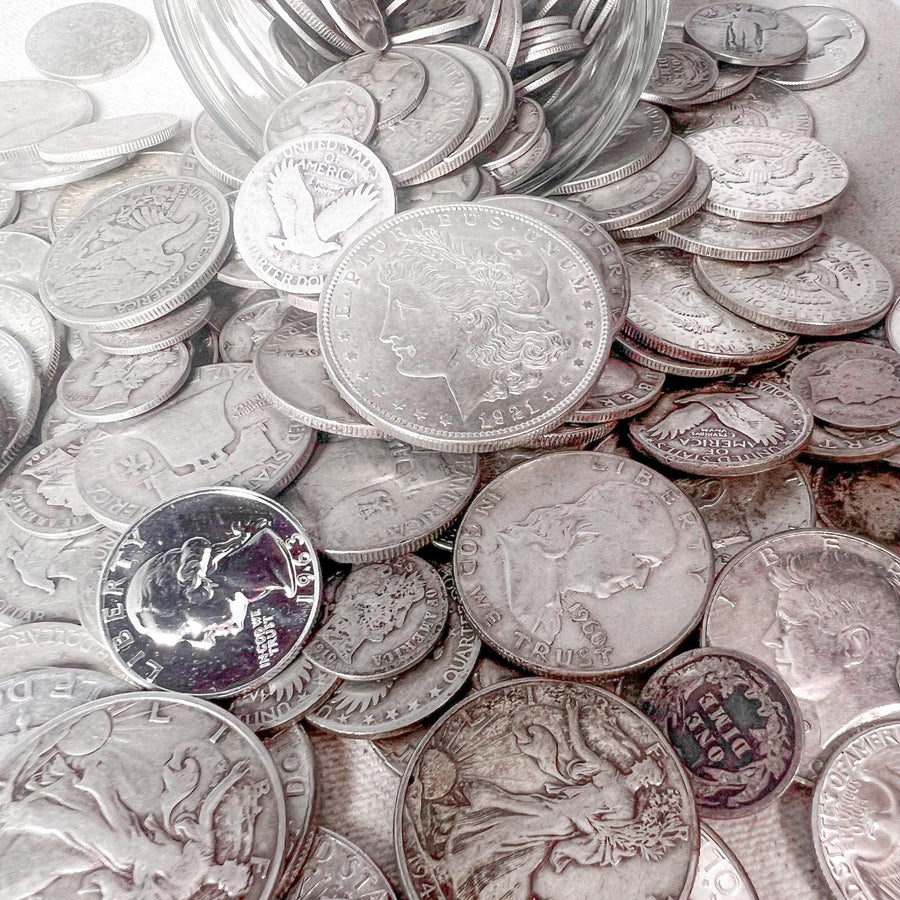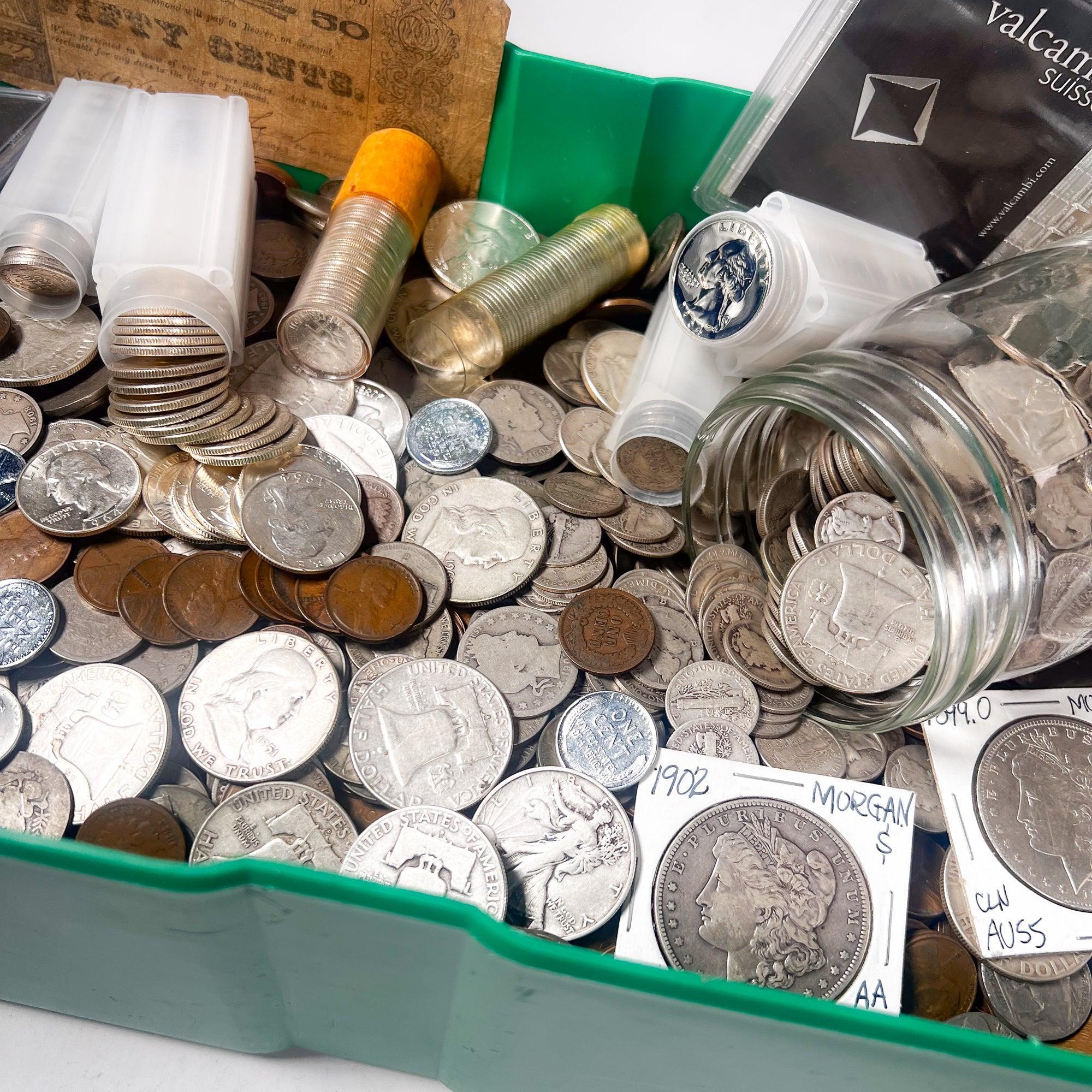Beyond Rarity: What Truly Determines Wheat Penny Value?
If you have any questions about wheat pennies, this post will undoubtedly answer all of them.
For many aspiring numismatists, the initial thrill of coin collecting often begins with the hunt for a specific date: the elusive 1909-S VDB, the stoic 1914-D, or perhaps the wartime 1943 Copper Penny. While these "key dates" are undeniably valuable, their rarity alone does not define a wheat penny's true worth.
The common misconception that date and mint mark are the sole determinants of value can lead collectors astray. This oversight causes them to overlook genuine treasures or overpay for common coins in poor condition. As a numismatic market analyst, my goal is to demystify the complete valuation process for wheat pennies, moving beyond the superficial knowledge of scarce dates to a deeper, expert-level understanding.
This comprehensive guide explores the nuanced factors influencing wheat penny value beyond just rare dates, including condition and errors, as well as the dynamic forces of market demand. A comprehensive understanding of coin grading, condition, and subtle error varieties is critical to accurately assess a wheat penny's true market value. Such knowledge empowers collectors to make more informed acquisition decisions and build a smarter, more valuable collection.
Beyond Date and Mint Mark: The Foundation of Wheat Penny Value
The allure of the wheat penny, produced from 1909 to 1958, extends far beyond its historical significance. For decades, it has been a cornerstone of American coin collecting. It captivates enthusiasts with its iconic design and the potential for uncovering hidden gems.
Understanding Key Dates and Mint Marks
Historically, certain combinations of date and mint mark have stood out as exceptionally rare and highly desirable. The 1909-S VDB leads this pack. Its limited mintage and initial public controversy over the prominent initials of designer Victor David Brenner cemented its legendary status.
Other notable contenders include the 1914-D and the 1931-S. Both are known for their low mintages relative to other years in the series, making them challenging to acquire. These specific dates command higher prices because their sheer scarcity, determined by original production numbers, makes them difficult for collectors to obtain in any condition.
However, this focus on key dates often fosters the common misconception that the date and mint mark are the only determinants of value. Many new collectors pour over price guides, seeking those specific years. They believe that finding any example of a key date instantly guarantees a significant payday. While a 1909-S VDB will always be valuable, its exact **Market Value** can swing wildly.
This swing is based on factors far more intricate than its original mintage figure. This perspective overlooks a vast landscape of factors that truly create a coin's market value, including its physical state, manufacturing anomalies, and broader market trends.
The Paramount Importance of Condition: Understanding Coin Grading
While a coin's date and mint mark define its inherent rarity in terms of mintage, its condition dictates its rarity in a collectible state. This distinction is critical. For most wheat pennies, even common ones, finding them in exceptional condition can make them far more valuable than a rare date in poor condition.
Why Condition Often Outweighs Rarity
Consider two scenarios. In scenario A, you unearth a highly sought-after 1914-D wheat penny. However, it is severely worn, has environmental damage, and perhaps a significant scratch across Lincoln's face. While undeniably a rare date, its poor condition will drastically limit its value, likely putting it in the tens or low hundreds of dollars.
In scenario B, you discover a common date, perhaps a 1943 Steel Penny, in pristine, "Mint State" condition, complete with original luster. Millions of these were produced, but finding one that looks like it just rolled off the press is exceedingly rare. This "common" 1943 Steel Penny in perfect condition could easily command hundreds, if not thousands, of dollars. This far exceeds the value of the beat-up 1914-D.
This illustrates the concept of "scarcity in high grades." Even for issues with millions, or even billions, of original pieces, the number of coins that have survived decades of circulation without significant damage is incredibly small. Thus, for many wheat pennies, the coin's condition becomes paramount, often outweighing mere mintage rarity in determining its ultimate worth.
The Sheldon Coin Grading Scale: A Comprehensive Guide
Accurately assessing a coin's condition requires a standardized approach. No system is more universally recognized than the **Sheldon Coin Grading Scale**. Developed by Dr. William H. Sheldon in the 1940s, this scale assigns a numerical grade from 1 to 70, with 70 representing a perfect coin. Its purpose is to provide a consistent, objective measure of a coin's preservation.
This allows collectors and dealers worldwide to communicate about a coin's condition with precision. This system is the bedrock for understanding **wheat penny grading scale** values.
Circulated Grades: Tracing a Coin's Journey
Circulated grades describe coins that have been used in commerce, showing varying degrees of wear. Each grade reflects a distinct level of detail remaining on the coin's surfaces. These coins have undergone the rigors of commerce.
Good (G-4)
A coin graded Good (G-4) is heavily worn, yet still identifiable. The major design elements are visible, but they are flat and lack sharpness. On a wheat penny, this means Lincoln's effigy will be heavily worn, with little detail in his hair or coat. The date and mint mark will be discernible, but the wheat stalks on the reverse will be very faint, often merging into the field.
Very Good (VG-8)
In Very Good (VG-8) condition, the coin shows moderate to heavy wear. While all major design elements are clear, they still lack sharpness. For a wheat penny, Lincoln's facial features will be present, but his beard line and cheek details will be flat. Some separation might be visible between the wheat stalks, but individual grains will be indistinguishable.
Fine (F-12)
A Fine (F-12) coin exhibits moderate wear. All legends and design elements are sharp and clear, though still somewhat flat. On a wheat penny, you would start to see some distinctness in Lincoln's hair lines and the folds of his coat. The wheat stalks would be more defined, with hints of individual grains, though overall flatness persists.
Very Fine (VF-20)
Very Fine (VF-20) describes a coin with light to moderate wear. All major details are clear, and some minor details may begin to show. For our wheat penny, Lincoln's cheek and jawline would have noticeable contour, and some of the finer details in his hair would be visible. The wheat stalks would show more distinct separation and some outline of the individual grains. The original mint luster would be completely gone.
Extremely Fine (EF-40)
An Extremely Fine (EF-40) coin shows only slight wear on the highest points of the design. The overall appearance is sharp and distinct, retaining much of the original detail. On a wheat penny, most of Lincoln's hair detail would be present, and the folds in his coat would be well-defined. The wheat stalks would be sharp, and nearly all individual grains would be outlined, though perhaps still flat.
About Uncirculated (AU-50, AU-58)
About Uncirculated (AU) coins are almost indistinguishable from uncirculated pieces, showing only the barest traces of wear on the highest design elements. An AU-50 coin will have some breaks in its original luster, usually on Lincoln's cheek or shoulder, or the center of the wheat stalks. An AU-58 is very nearly "Mint State," exhibiting only the slightest friction on the very highest points, visible only under magnification, with almost full original luster intact. This category bridges the gap between **Circulated** and uncirculated.
Uncirculated Grades: The Pinnacle of Preservation (MS-60 to MS-70)
The **Mint State** (MS) designation is reserved for coins that have never entered circulation. These coins retain their original mint luster and show no signs of wear, though they may have minor imperfections from the minting process itself, such as bag marks or minor toning. This is where the concept of **uncirculated wheat penny value** truly comes into play.
Defining Mint State (MS)
A coin is classified as Mint State if it has never been subjected to the rigors of commerce. This means its surfaces are untouched by friction, preserving the coin's original texture and strike. Any imperfections on an MS coin are considered "contact marks" or "bag marks." These are sustained during the minting and bagging process, not from handling or circulation.
The Importance of Luster and Surface Preservation
For uncirculated coins, luster is paramount. This refers to the original metallic sheen created when the coin is struck, which reflects light in a specific way. A coin with full, vibrant luster suggests it has been properly stored and handled, free from environmental damage or cleaning. Surface preservation, meaning the absence of scratches, hairlines, nicks, or other post-mint damage, is equally vital. A coin's luster and pristine surfaces directly correlate with its numerical grade within the MS range.
Decoding Color Designations: Full Red (RD), Red-Brown (RB), and Brown (BN)
For copper coins like wheat pennies, color plays a significant role in determining value within the uncirculated grades.
- Full Red (RD): This designation is given to coins that retain nearly all (95%+) of their original brilliant copper color. These coins are exceptionally rare and highly sought after, as copper naturally tones over time.
- Red-Brown (RB): Coins with this designation show a mix of original red and some toning to brown (typically 5% to 95% red). This is a common state for uncirculated copper.
- Brown (BN): These coins have completely toned to shades of brown, having lost all their original red luster. While still uncirculated, they are typically less valuable than their RD or RB counterparts, all else being equal.
The shift from RD to BN over time is natural for copper, but a strong, vibrant original red color indicates exceptional preservation and significantly boosts value.
Understanding Incremental Value Jumps within MS Grades
The difference between an MS-63 and an MS-65, or an MS-65 and an MS-67, can be astounding in terms of value. These incremental jumps are driven by minute differences in surface preservation, luster, and strike sharpness. A coin might only have one or two fewer microscopic bag marks to jump from an MS-65 to an MS-66, but that small improvement can mean the difference of hundreds or even thousands of dollars for key dates or very desirable common dates. The ultimate value of an **uncirculated wheat penny value** hinges on these subtle distinctions.
Professional Coin Grading Services (PCGS, NGC, ANACS)
Given the subjective nature of human observation and the significant value implications, third-party professional coin grading services such as PCGS, NGC, and ANACS have become indispensable. They offer essential authentication and valuation.
The Role of Third-Party Grading
These services offer objective, consistent, and expert opinions on a coin's grade. They authenticate its genuineness, and encapsulate it in a sealed, tamper-evident plastic holder, known as "slabbing." This process mitigates disputes over grade and provides a recognized standard for the marketplace. Their authentication also helps collectors avoid fakes, a pervasive issue in numismatics.
Benefits and Costs of Slabbing Coins
The primary benefits of slabbing include:
- Authentication: Verifying the coin is genuine.
- Standardized Grading: Providing an objective, widely accepted grade.
- Protection: Preserving the coin's condition in a secure holder.
- Market Liquidity: Graded coins are generally easier to buy and sell due to established trust.
However, slabbing is not without cost. It is essential to ensure the potential increase in value justifies the grading fee for your specific coin.
Interpreting Population Reports
Grading services maintain "population reports," which track the total number of coins they have graded for each specific date, mint mark, and grade. This data provides invaluable insight into true scarcity. If a coin has a very low population in a specific high grade, it signals extreme rarity, driving up market value significantly. Conversely, a coin with a high population in a specific grade suggests it is relatively common in that condition, tempering its value.
Impact of Post-Mint Damage (PMD) vs. Wear
Distinguishing between wear from circulation and damage inflicted after the minting process, known as Post-Mint Damage (PMD), is crucial. PMD can drastically diminish or even negate a coin's numismatic value. It is a critical factor in valuation.
Common Types of PMD
- Cleaning: This is the most common and destructive PMD. A cleaned coin, even if it looks shiny, loses its original surface integrity and luster, making it undesirable to serious collectors. Signs include hairlines from abrasive cloths, an unnatural "brushed" appearance, or a lack of original luster.
- Scratches: These are accidental or intentional marks that break the coin's surface.
- Environmental Damage: This includes corrosion, pitting, or discoloration from exposure to harsh chemicals, moisture, or extreme temperatures.
- Altered Surfaces: Any attempt to chemically or physically modify the coin's original surface beyond light handling.
How PMD Significantly Diminishes Value
Professional graders will either assign a "details" grade, such as VF Details, Cleaned, or refuse to grade a coin with significant PMD. This indicates it has no collectible value beyond its metallic content. A rare date with PMD will almost always be worth less than a common date in a genuinely high, undamaged grade. This emphasizes that condition, free from artificial alterations, is often paramount over just rarity for common dates.
Unraveling Wheat Penny Errors and Varieties: A Value Multiplier
Beyond meticulous condition and low original mintage, a fascinating category exists for collectors: errors and varieties. These anomalies, unintended during the minting process, can transform a common coin into a highly prized rarity, acting as a significant value multiplier.
Distinguishing Between True Errors and Minor Die Varieties
It is important to clarify the terminology. An "error" refers to an accidental malfunction or deviation during the minting process, resulting in a coin that differs significantly from standard production, such as being struck off-center. A "variety," on the other hand, describes an intentional, though sometimes subtle, modification to a die during its creation or use that results in minor, consistent differences in coins produced from that die. In a strict numismatic sense, varieties are often deliberate, albeit minor, alterations or anomalies on the die itself.
How Errors Are Formed and Why They Are Collectible
Coin errors are formed when something goes wrong at any stage of the minting process. These stages include issues with the blank coin (planchet) before it is struck, problems with the dies themselves, or malfunctions during the striking of the coin. They are collectible precisely because of their rarity and uniqueness.
Each error represents a fleeting moment of imperfection in a highly mechanized, precision process. Collectors are drawn to these "one-of-a-kind" pieces, which offer a tangible glimpse into the history of coin production. The more dramatic, recognizable, and scarce the error, the higher its value.
Major Wheat Penny Error Types and Their Impact on Value
The world of the **wheat penny error list** is rich and complex. Here are some of the most notable types.
Doubled Die (DDO/DDR)
A **Doubled Die** occurs when a coin die receives multiple, slightly misaligned impressions from the hub during its creation. This results in a clear, distinct doubling of design elements, usually letters, numbers, or features. The primary cause is improper hubbing, where the hub, a master die, strikes the working die more than once, with a slight rotation or shift in between strikes. The most famous example is the 1955 Doubled Die Obverse (DDO) wheat penny, where the date and "LIBERTY" are boldly doubled.
True doubled die will show a distinct, separate doubling, often with serifs or features appearing split. "Machine doubling," also called "bounce doubling," is far more common. It occurs when the die moves slightly during the actual striking of the coin. Machine doubling appears as a flattened, shelf-like distortion, rather than a distinct second image. Learning to spot the difference is crucial to identifying truly valuable doubled dies. The degree of doubling, its visibility, and the coin's overall condition are paramount value drivers.
Off-Center Strikes
An **Off-Center Strike** occurs when the planchet is not properly seated within the coining press. This results in a coin that is struck with part of its design missing and a blank area on the opposite side. The planchet simply is not centered correctly when the dies come together. The degree of off-centerness significantly impacts value.
A coin that is 5 to 10% off-center might be a minor novelty, but one that is 50% or more off-center, yet still retains the full date and mint mark, can be highly valuable. Crucially, the date and mint mark must be present for the error to be fully identifiable and thus more desirable.
Repunched Mint Marks (RPMs) and Overdates
**Repunched Mint Marks** (RPMs) occur when the mint mark, such as "D" for Denver or "S" for San Francisco, was punched onto the working die more than once, with a slight shift in position between punches. This often results in a doubled, triple, or otherwise misaligned mint mark.
Before 1990, mint marks were individually hand-punched onto each working die. If the punch was not struck hard enough, or if it shifted, it would be repunched, creating the RPM. Numerous RPMs exist throughout the wheat penny series, such as the 1944-D/D RPM or the 1958-D/D RPM.
An **overdate** occurs when the die used a previous year's date, and the new year's date was punched over it, leaving remnants of the older date visible. A classic example, though not a wheat penny, is the 1942/1-D Mercury Dime, where the "1" is clearly visible under the "2." While less common for wheat pennies, understanding the concept is key to recognizing such rarities across U.S. coinage.
Die Breaks and Cuds
Coin dies, under immense pressure, can wear down and crack over time. These imperfections translate to raised features on the struck coins. Continuous use and stress on the dies lead to fatigue and fracturing. A "Die Break" is a small crack on the die that appears as a raised line or blob on the coin. These can vary widely in size and shape.
A "Cud" is a larger, more significant **Die Break** that occurs when a piece of the die actually breaks off at the rim and extends into the field of the coin. Cuds create a raised, irregular blob of metal on the coin's surface, often shaped like the missing die piece.
The size, location, and distinctiveness of the break or cud are key value considerations. Larger, more dramatic cuds, especially those that involve major design elements, are more valuable.
Planchet Errors
Problems can occur with the blank metal disc, the planchet, before it even reaches the striking chamber.
- Clipped Planchets: These occur when the strip of metal from which the planchets are punched is misfed, resulting in a coin with a curved or straight portion of its edge missing.
- Lamination Errors: Flaws in the metal composition of the planchet can cause layers of the metal to peel or flake off the coin's surface after it is struck. This appears as a raised or peeling section on the coin.
- Wrong Planchet Errors:** These are among the most exciting and valuable errors. They occur when a coin is struck on a planchet intended for a different denomination or metal composition. The 1943 Copper Penny is the most famous wheat penny error. This coin was mistakenly struck on a bronze (copper) planchet instead of the standard steel planchet used in 1943.
- Only about 40 are known, making them extremely rare and valued in the millions. Conversely, a penny struck on a steel planchet in 1944, when copper was standard again, is also exceedingly rare and valuable. These represent a perfect storm of error and rarity, commanding some of the highest **Auction Record** prices in numismatics.
This broad **wheat penny error list** demonstrates the diverse ways in which a coin can deviate from its intended form, often increasing its value exponentially.
Beyond the Coin Itself: Market Dynamics and Collector Strategies
Understanding the physical attributes of a wheat penny is essential. However, a truly informed collector also grasps the broader market forces that ultimately determine a coin's selling price.
Understanding Market Demand and Scarcity
The true **Market Value** of any coin, including a wheat penny, is fundamentally driven by the classic economic principles of supply and demand. If many collectors seek a particular coin (high demand) and only a few are available (low supply), the price will naturally rise. Conversely, if a coin is plentiful and interest wanes, its value may stagnate or even decline.
The popularity of specific series or themes can significantly influence demand. Wheat pennies, being a foundational series for many collectors, generally enjoy consistent demand. However, specific sub-series, like error varieties, can experience surges in popularity.
Population reports from PCGS, NGC, and ANACS are critical. They provide real-time, data-driven insights into how many examples of a particular coin in a specific grade truly exist. If a report shows only a handful of examples of a common date in MS-67 Red, that coin instantly becomes extraordinarily rare in that condition. This drives its market price far beyond that of a lower-grade key date. Consider the 1943 Steel Cent.
While initially common, a superb, fully original MS-67 example, particularly with full luster, can fetch thousands today. Conversely, a 1914-D in G-4 might struggle to find a buyer for much over $100.
This illustrates that a common coin with extraordinary condition can often outperform a rare coin with poor condition on the open market, due to the extreme scarcity of top-tier examples. We have seen **Auction Record** after **Auction Record** for seemingly "common" dates when they emerge in pristine grades.
The "Red Book" as a Valuation Tool
For decades, the **"Red Book" (A Guide Book of United States Coins)** has been an indispensable resource for collectors. It offers a comprehensive overview of U.S. coinage, including estimated values for various types, dates, and grades. The Red Book provides a fantastic starting point.
It lists values for different **Circulated** and uncirculated grades for most dates and prominent error varieties. It allows a collector to quickly gauge a coin's general ballpark value based on its condition. For example, you can look up a 1926-S wheat penny and see estimated values for G-4, VF-20, EF-40, AU-50, and various MS grades.
It is crucial to understand the Red Book's limitations. Its prices are retail averages, not real-time **Market Value** quotes. They reflect what a dealer might sell a coin for, not necessarily what they would buy it for, which is typically lower, or wholesale. Furthermore, by the time the annual Red Book is printed and distributed, market conditions, auction records, and population reports may have shifted, making some prices outdated.
To get the most accurate and up-to-date valuation, you must supplement the Red Book with current market data. This means consulting major auction house results, like Heritage Auctions or Stacks & Bowers, for realized prices. It also means reviewing online dealer inventories and monitoring professional grading service population reports. These resources provide a real-time pulse of the market, which is especially important for high-value or exceptionally rare coins.
Recognizing Fakes and Counterfeits: Protecting Your Investment
One of the most significant challenges in collecting, particularly with valuable coins like key date wheat pennies or known errors, is the prevalence of fakes and counterfeits. Understanding how to spot them is paramount to protecting your investment.
Common Counterfeiting Methods for Wheat Pennies
- Altered dates or mint marks: A common method is to alter a less valuable coin to mimic a rare one. For example, a counterfeiter might take a common 1944-D cent and attempt to alter the "4" to a "1" to create a fake 1914-D. Similarly, adding a fake "S" mint mark to a common Philadelphia-minted coin is another tactic.
- Casting vs. striking: Genuine coins are struck under immense pressure, resulting in sharp details and a distinct "cartwheel" luster. Counterfeit coins, especially older ones, are often cast. Telltale signs of casting include a dull, granular, or sandy surface texture.
- Other signs are a lack of sharp detail, appearing "mushy" or soft, porous surfaces or tiny bubbles visible under magnification, and seams along the edge where the molds met.
- Re-engraving or adding features: Some fakes involve re-engraving details to make a worn coin appear sharper or adding features to create a fake error, such as manually incising lines to mimic a **Doubled Die**.
Key Identification Techniques for Spotting Fakes
- Magnification and detailed examination. A good quality jeweler's loupe (10x to 20x magnification) is essential. Examine the date, mint mark, and fine details of the design. Look for inconsistencies, altered numbers, or tool marks around the letters. Compare suspicious areas to known genuine examples; photos from reputable sources are invaluable.
- Weight and diameter checks: Each denomination has a standard weight and diameter. A precision scale and calipers can reveal whether a coin meets the correct specifications. For example, a genuine 1943 Steel Penny weighs 2.7 grams. A copper penny from that year (the extremely rare error) would weigh 3.11 grams. Any significant deviation should raise a red flag.
- Sound (the "ring" test): A genuine, solid coin, when lightly tapped or dropped on a hard surface, produces a clear, distinct "ring." Counterfeit coins, especially cast ones, often produce a dull thud or a dead sound due to their composition or internal imperfections. Caution: This test can damage coins if done improperly. Use extreme care or avoid for valuable pieces.
- Luster and surface analysis: As discussed with grading, genuine mint luster is unique. Fakes often have an unnatural sheen, a dull appearance, or surfaces that show signs of cleaning or artificial toning.
The Importance of Provenance and Reputable Sources
The simplest and most effective way to avoid counterfeits is to always buy from trusted sources. Reputable coin dealers have a vested interest in their reputation and expertise in authentication. Professional coin grading services, such as PCGS, NGC, and ANACS, offer the ultimate safeguard. Buying coins that have been slabbed by these services is a reliable way to ensure authenticity and grade.
Reputable auction houses thoroughly vet their consignments. Midwest Precious Metals offers a selection of graded wheat pennies, professionally authenticated and described to help you understand their condition and value, providing peace of mind to collectors.
Proper Storage and Preservation: Maintaining and Enhancing Value
Once you have acquired valuable wheat pennies, proper storage and preservation are crucial to maintaining, and potentially enhancing, their value over time. A coin's condition can deteriorate rapidly if not cared for correctly.
- Best practices for handling coins: Always handle coins by their edges. The oils, dirt, and acids from your skin can permanently mark or damage a coin's surface, particularly for copper coins, which are very reactive. Even slight smudges can cause toning or reduce a coin's grade.
- Recommended storage materials: Use archival-safe Mylar or polypropylene flips. These are chemically inert and safe for long-term storage. PCGS, NGC, or ANACS Slabs provide the best protection and preservation. Albums with inert pages are also recommended. Ensure the album pages are explicitly stated to be PVC-free.
- Materials to avoid: Do not use PVC (Polyvinyl Chloride) flips. These plasticizers will leach out over time and react with the coin, creating a sticky, green residue that permanently damages the coin's surface. This is a common and irreversible mistake. Also avoid paper envelopes with high acid content, as they can cause toning or spotting.
- Environmental factors: Store coins in a stable environment. High humidity can accelerate toning and corrosion, especially for copper coins. Extreme temperature fluctuations can also be detrimental. Direct sunlight or strong artificial light should be avoided as it can also influence toning. A cool, dry, dark place is ideal.
Proper preservation ensures that your coin's condition, and thus its **Market Value**, remains stable or even appreciates. A coin that looks as good in 20 years as it does today will always be more valuable than one that has deteriorated due to neglect. This is a direct investment in the longevity of your collection.
Building a Smarter Wheat Penny Collection
Armed with a deeper understanding of grading, errors, and market dynamics, you can approach collecting wheat pennies with a more strategic and informed perspective.
Defining Your Collection Goals
Before buying, consider what kind of collection you want to build.
- Focusing on Rarity: Some collectors prioritize owning key dates, even if it means acquiring them in lower, affordable grades. This approach aims to complete a date and mint mark set, regardless of pristine condition. It is often an entry point for many, due to the difficulty of identifying valuable wheat pennies solely by date.
- Prioritizing Condition: Many seasoned collectors aim for high-grade common dates, seeking "condition rarities." They might try to assemble a complete set of wheat pennies, with every coin graded MS-65 Red or better. This strategy is immensely challenging but yields a collection of exceptional beauty and often, substantial value.
- Specializing in Errors: A dedicated pursuit of specific error types or unique varieties can be a lifelong endeavor. Collectors might focus on **Doubled Die** pennies, **Off-Center Strike** examples, or even collecting a specific error type across different denominations. This requires deep knowledge of the **wheat penny error list** and meticulous searching.
- Assembling a Date/Mint Mark Set: This is the classic approach. It involves acquiring one example of every date and mint mark combination from 1909 to 1958. This provides a comprehensive overview of the series.
- The Joys of Type Collecting: This involves acquiring representative examples of different eras or designs within the wheat penny series. For instance, obtaining a strong example of a 1909 VDB (early type), a wartime steel cent, and a later copper cent to show the evolution.
Strategic Acquisition: Where to Buy and Sell
Knowing where to buy and sell is as important as knowing what to buy.
- Reputable Coin Dealers: Dealers offer expertise, a curated inventory, and often, a return policy. They are excellent sources for authenticated, accurately graded coins. Midwest Precious Metals, for instance, focuses on professionally authenticated and described graded wheat pennies, simplifying the acquisition process for collectors seeking quality and value.
- Coin Shows and Conventions: These events offer a vast selection, competitive pricing, and the opportunity to physically inspect coins and network with other collectors and dealers.
- Online Marketplaces and Auctions:** Platforms like eBay, Stack's Bowers, and Heritage Auctions offer immense variety but require caution. Vetting sellers, reviewing high-resolution images, and understanding return policies are crucial. For higher value coins, stick to well-known auction houses.
- Estate Sales and Flea Markets: These can be thrilling places to find hidden gems, but they come with higher risk. The chances of encountering counterfeits or damaged coins are greater, requiring the collector to be highly knowledgeable and vigilant.
The Long-Term Investment Potential of Wheat Pennies
While collecting should primarily be a hobby driven by passion, wheat pennies can also represent a tangible asset and an alternative investment. Unlike stocks or bonds, coins are physical assets that you can hold and appreciate. In times of economic uncertainty, tangible assets can be appealing to investors.
Coins that demonstrate genuine rarity, meaning low mintage and low population in high grades, coupled with sustained collector demand and compelling historical significance, are most likely to appreciate over the long term.
Ultimately, the true value of coin collecting extends far beyond financial returns. It is the joy of the hunt, the connection to history, the aesthetic appreciation of numismatic art, and the satisfaction of building a meaningful collection that enriches life.
Building a Smarter, More Valuable Wheat Penny Collection
The journey of collecting wheat pennies is far more intricate and rewarding than simply memorizing a handful of key dates. While the 1909-S VDB will always hold its legendary status, the true depth of factors influencing wheat penny value beyond just rare dates, including condition and errors, lies in understanding the complete valuation spectrum. From the subtle nuances of the **Sheldon Scale** and the rarity of a coin achieving **Mint State** with **Full Red** luster, to the fascinating world of errors like the **Doubled Die** or **Off-Center Strike**, each element contributes to a coin's unique story and its place in the market.
Remember, condition often holds paramount importance. It transforms common dates into significant treasures due to their "scarcity in high grades." The impact of factors like **Repunched Mint Marks** or a unique **Die Break** can turn an ordinary coin into a numismatic curiosity commanding a premium.
By embracing a deeper understanding of grading, tirelessly studying **wheat penny error list** characteristics, and staying attuned to **Market Value** and demand factors, informed by resources like the **Red Book** and **Auction Record** data, you move beyond simply finding coins to truly assessing their worth. This comprehensive knowledge allows you to protect your investment by recognizing fakes and ensures your collection is preserved for generations.
Whether you are beginning your collection or refining an existing one, the single most important message to take away is this: A comprehensive understanding of coin grading, condition, and subtle error varieties is critical to accurately assess a wheat penny's true market value. Embrace the analytical approach, and your collecting journey will be infinitely more informed, engaging, and rewarding.
Consider exploring professionally graded wheat pennies offered by reputable dealers like Midwest Precious Metals. Their selection of authenticated and described coins can provide excellent examples to deepen your understanding of condition and value, helping you make truly informed acquisition decisions for your growing collection.
If you are interested in started to collect today, check out our selection of wheat pennies that have all been verified authentic.












